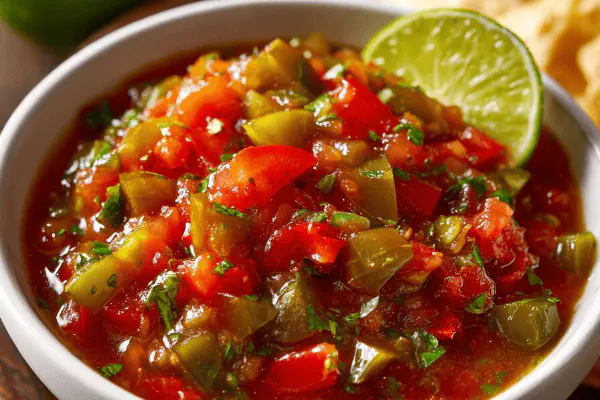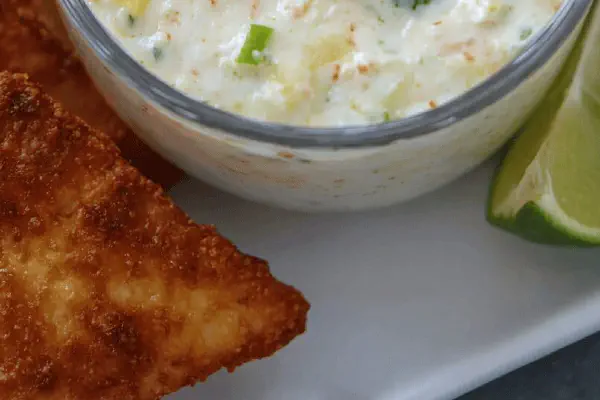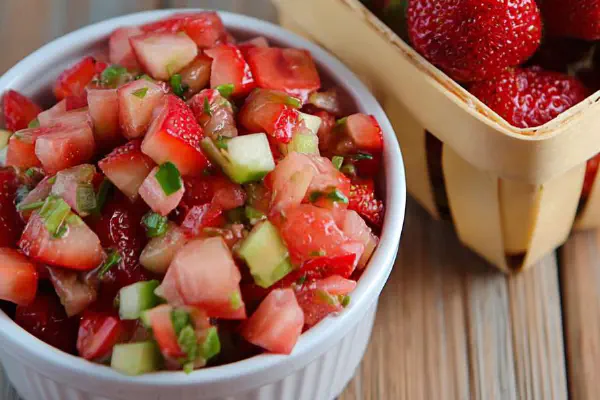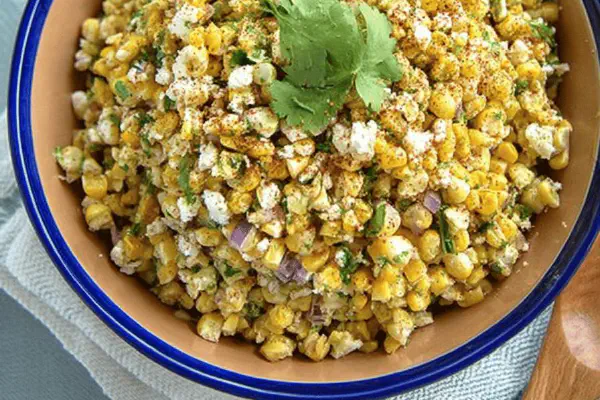Chunky Fiery Salsa

By Emma
Certified Culinary Professional
Ingredients
- 45 ml (3 tablespoons) cornstarch
- 85 ml (about 1/3 cup plus 2 teaspoons) fresh lime juice
- 1.4 kg (about 3 lbs) ripe plum tomatoes coarsely chopped
- 1 can 520 ml (about 18 oz) husked tomatillos, drained and quartered
- 1 large white onion, finely chopped
- 3 colored bell peppers, deseeded and diced small
- 1 medium green bell pepper, deseeded and diced small
- 100 ml (7 tablespoons) finely chopped jalapeños, adjust heat at will
- 3 cloves garlic, minced
- 1 small can 156 ml (5 1/2 oz) tomato paste
- 150 ml (2/3 cup) apple cider vinegar, alternative to white vinegar
- 20 ml (1 1/3 tablespoons) brown sugar
- 12 ml (roughly 3 teaspoons) coarse pickling salt
- 20 ml (1 1/3 tablespoons) smoky chipotle sauce
- 20 ml (1 1/3 tablespoons) smoked paprika
About the ingredients
Method
- Gather lids and sterilized jars you’ll need. Have a clean kitchen towel ready for wiping rims later.
- In a small bowl, mix cornstarch with 45 ml lime juice; stir smooth. Set aside. This slurry thickens without clumps.
- Combine tomatoes, tomatillos, onion, all peppers, jalapeños, garlic, tomato paste, vinegar, sugar, salt, chipotle sauce, smoked paprika in heavy pot. High heat to brisk boil, then moderate to steady simmer. Stir often, listen for slow bubbling sound, skin breaking down, veggies softening—about 30 minutes.
- When salsa looks thickening, shiny, and just slightly loose, stir in cornstarch mixture. Cook 3 more minutes, watch texture: should cling slightly to spoon, not watery nor gelatinous.
- Taste now, tweak salt or heat. Salsa should hit balance: smoky heat, tartness, sweet hints.
- Ladle salsa carefully into hot jars, leaving 1 cm headspace. Use a non-metal spatula or chopstick to pop air bubbles; don’t skip or jars may explode in bath.
- Wipe jar rims clean with damp cloth—no stickiness or debris. Center lids, screw bands finger-tight, no wrench torque.
- Set jars on canning rack in pot, cover with 2.5 cm water minimum. Bring to rolling boil over high flame, cover pot. Once boiling, timer 18 minutes starts (slightly longer for altitude and safety).
- Remove jars with tongs, cool upright on towel. Lids will pop down with a satisfying click. If any don’t seal, refrigerate and use first.
Cooking tips
Chef's notes
- 💡 Cornstarch slurry added late makes all the difference—prevents lumps, keeps that shiny finish. Stir the slurry smooth, no chunks. Watch salsa before adding slurry. Should look thickening but still a little loose—like syrup about to set. Overcook after adding, it gets gummy and weird. Scoop with spoon see if it clings lightly, not runny or gluey. Timing matters about 3 minutes max. Texture cues trump timers here.
- 💡 Peppers diced uniformly stop floating bits and prevent sealing issues when canning. Don’t rush dice—small pieces soften evenly, no bitter tough skins lingering. Use serranos or poblanos to tailor heat but dial jalapeños carefully. Adjust quantity by bite after cooldown test or tasting first thin batch after simmer. Heat grows after cooking, so shy on fresh chili. Remember chipotle sauce brings smoke and heat layers differently—balance with brown sugar.
- 💡 When jars fill try not to trap air bubbles—they cause cracks during bath canning or jeopardize seal. Use wooden chopstick or silicone spatula to prod air out. Wipe rims with damp towel thoroughly. If lids sit lopsided or sticky rims remain, jar might fail seal. Screw bands finger tight only. No wrench torque—just snug. Water bath always at least 2.5 cm over jars. Hot water top off anytime during boil prevents evaporation dry spots.
- 💡 Simmer time at medium heat is the base—maybe 30 minutes. Listen for slow bubble rhythm, not roaring boil. Vegetables breaking down aroma subtle but tell when skin feels softer in pot and color deepens. Stir often to avoid bottom browning but not so often you lose bubbles. Pop of garlic and chipotle aroma comes late near finish. Avoid rushing—early boil scorches veggies making bitter peel fragments.
- 💡 Adjustment salt: pickling salt preferred over table salt as iodine/anti-caking agents foul ferment and flavor. If desperate rinse table salt well or reduce quantity by half. Sugar compensates acidity but keep balance with vinegar to avoid cloy. Vinegar swap apple cider for white vinegar changes warmth and mild fruitiness, less harsh. Lime juice added extra at end pulls back textures from stew into bright salsa punch. Always taste late stage to tweak.
Common questions
Why add cornstarch slurry late?
Prevents clumping and cloudy salsa. Adding early swells starch too much, gummy texture forms. Wait for salsa to thicken first—then swirl slurry in and cook only few minutes. Texture thick but shiny.
Can I use fresh vs canned tomatillos?
Fresh preferred when in season—wash sticky coating off well or flavors turn odd. Canned okay as backup but rinse to reduce brine salt. Fresh tomatillos boost acidity and body distinctly. Season timing matters for freshness.
What if salsa is too thin after cooking?
Stir slurry in gradually. If still thin after 3 minutes cook, add small pinch more cornstarch in lime juice water mix. Avoid dumping dry starch. High heat breaks texture. Alternative is longer simmer but risk bitter peel bits. Cornstarch safer.
How to store salsa after opening?
Refrigerate promptly with lid sealed. Use within few weeks ideally. Freeze option works if jar full enough with air minimized. Don’t reuse jars once opened for long term unless reprocessed. Label with dates. Avoid leaving at room temperature once opened.



